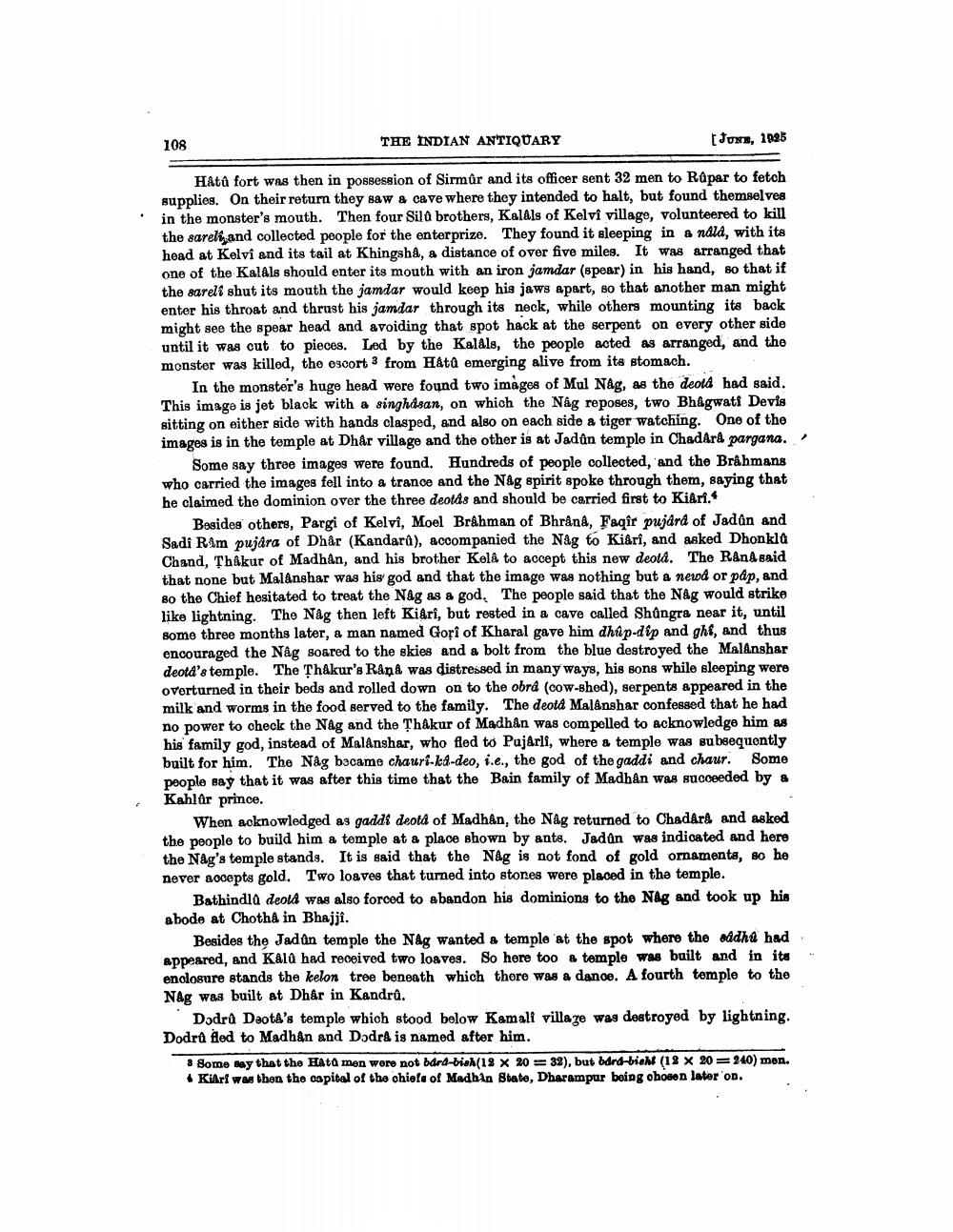________________
108
THE INDIAN ANTIQUARY
[Tona, 1925
Hâtû fort was then in possession of Sirmûr and its officer sent 32 men to Räpar to fetch supplies. On their return they saw a cave where they intended to halt, but found themselves in the monster's mouth. Then four Sild brothers, Kaláls of Kelvi village, volunteered to kill the sareli and collected people for the enterprize. They found it sleeping in a náld, with its head at Kelvi and its tail at Khingsha, a distance of over five miles. It was arranged that one of the KalAls should enter its mouth with an iron jamdar (spear) in his hand, so that if the eareli shut its mouth the jamdar would keep his jaws apart, so that another man might enter his throat and thrust his jamdar through its neck, while others mounting its back might see the spear head and avoiding that spot hack at the serpent on every other side until it was cut to pieces. Led by the Kalals, the people acted as arranged, and the monster was killed, the escort 3 from Hata emerging alive from its stomach.
In the monster's huge head were found two images of Mul Nag, as the deotd had said. This image is jet black with a singhdsan, on which the Nag reposes, two Bhagwati Devis sitting on either side with hands clasped, and also on each side & tiger watching. One of the images is in the temple at Dhår village and the other is at Jadân temple in Chadará pargana.
Some say three images were found. Hundreds of people collected, and the Brâhmans who carried the images fell into a trance and the Nag spirit spoke through them, saying that he claimed the dominion over the three deotds and should be carried first to KiAri.
Besides others, Pargi of Kelvi, Moel Brahman of Bhrând, Fagîr pujard of Jadan and Sadi Ram pujara of Dhår (Kandara), accompanied the Någ to Kiari, and asked Dhonkla Chand, Thákur of Madhân, and his brother Kelå to accept this new deold. The Rånå said that none but Malanshar was his god and that the image was nothing but a newd or páp, and 80 the Chief hesitated to treat the Någ as a god, The people said that the Nag would strike like lightning. The Nag then left Kiari, but rested in a cave called Shûngra near it, until some three months later, a man named Gori of Kharal gave him dhúp-dip and ght, and thus encouraged the Någ soared to the skies and a bolt from the blue destroyed the MalAnshar deotá's temple. The Thakur's Rånd was distressed in many ways, his sons while sleeping were overturned in their beds and rolled down on to the obra (cow-shed), serpents appeared in the milk and worms in the food served to the family. The deota Malanshar confessed that he had no power to check the Nag and the Thakur of Madhan was compelled to acknowledge him as his family god, instead of Malánshar, who fled to Pajarli, where a temple was subsequently built for him. The Nag became chauri-ka-deo, i.e., the god of the gaddi and chaur. Some people say that it was after this time that the Bain family of Madhan was succeeded by a Kahlûr prince.
When acknowledged as gaddi deota of Madhân, the Nag returned to Chadard and asked the people to build him a temple at a place shown by ants. Jadûn was indicated and here the Någ's temple stands. It is said that the Nag is not fond of gold ornaments, so he never accepts gold. Two loaves that turned into stones were placed in the temple.
Bathindia deod was also forced to abandon his dominions to the Nag and took up his abode at Chotha in Bhajji.
Besides the Jadun temple the Nag wanted a temple at the spot where the eddha had appeared, and Kald had received two loaves. So here too a temple was built and in its enclosure stands the kelon tree beneath which there was a danoe. A fourth temple to the Nag was built at Dhar in Kandrů.
Dodrů Daota's temple which stood below Kamall village was destroyed by lightning. Dodro Aled to Madh&n and Dodrá is named after him.
8 Some say that the Hatd men were not bdrd-bish(19 X 20 = 32), but odno-biekt (13 X 20 = 240) men. * Kiarf was then the capital of the ohiole of Madhin State, Dharampur being chosen later on.
-




